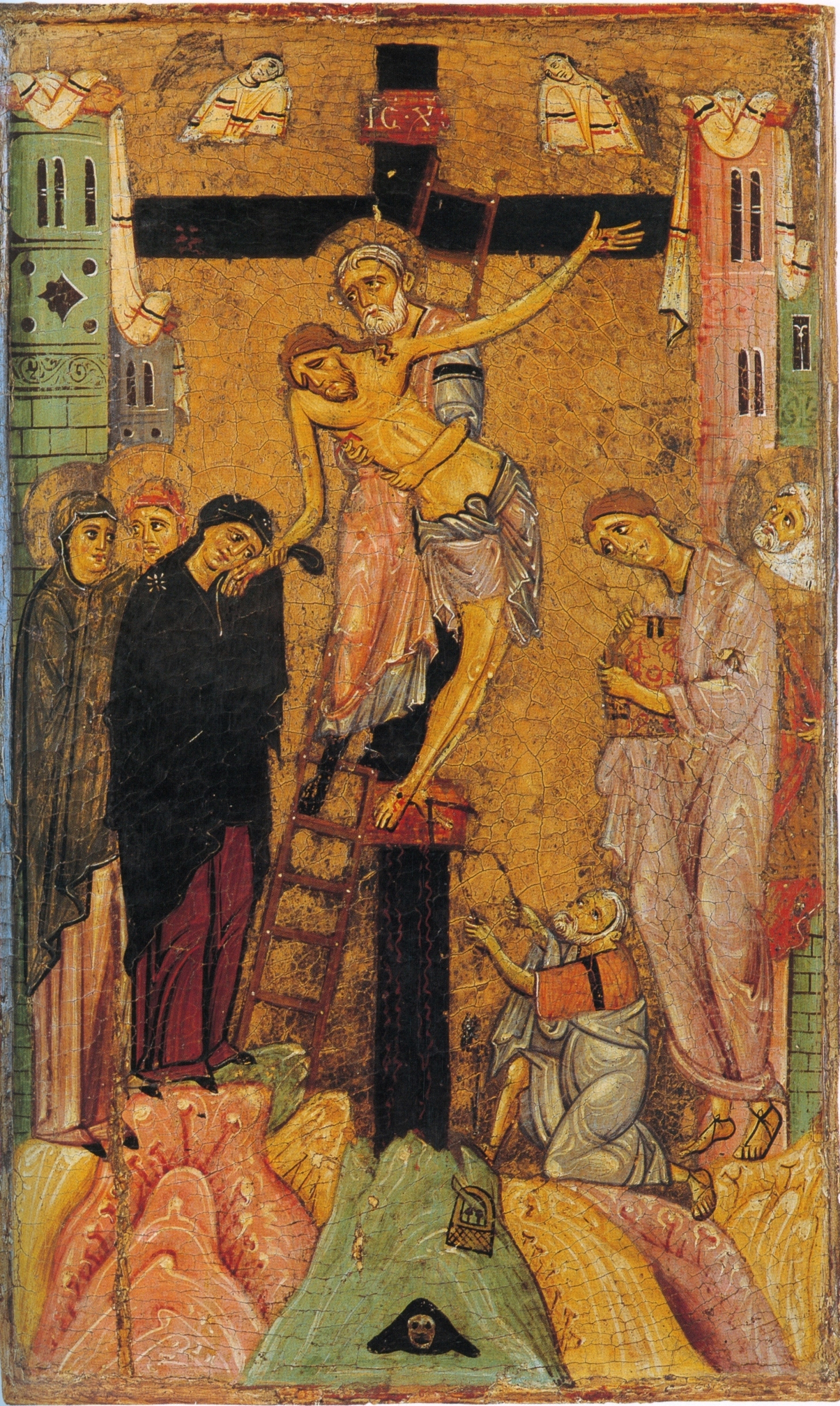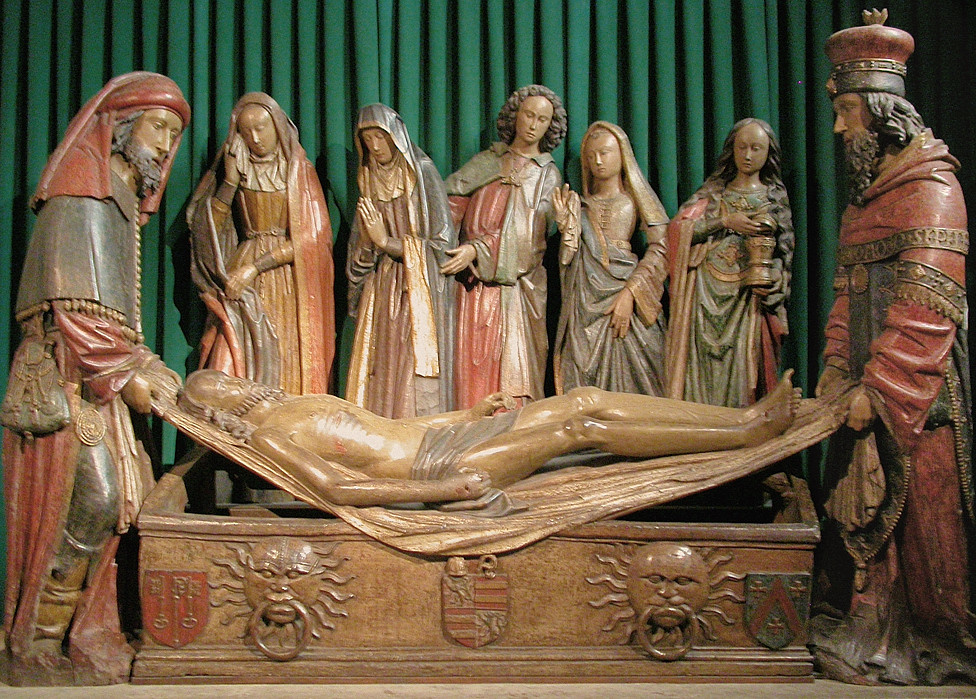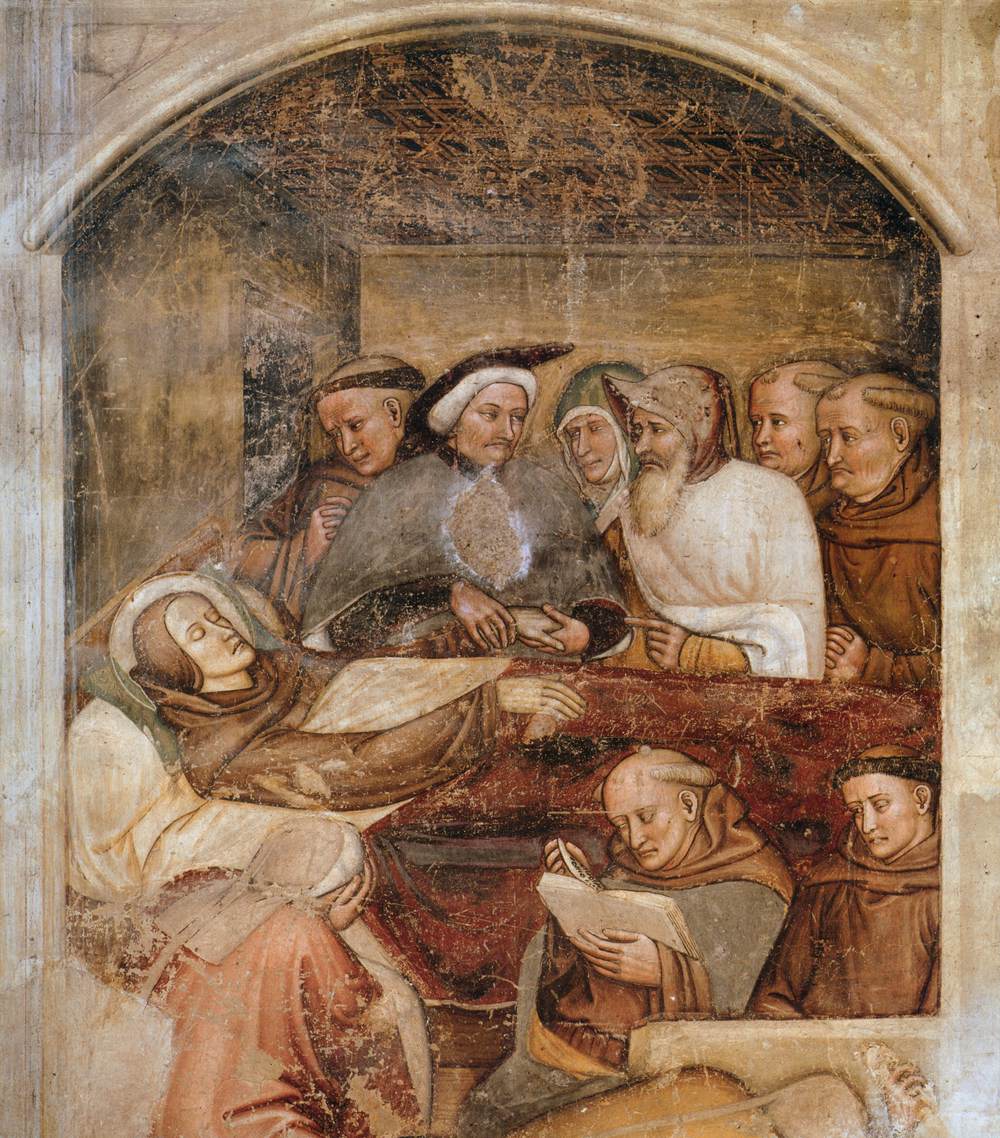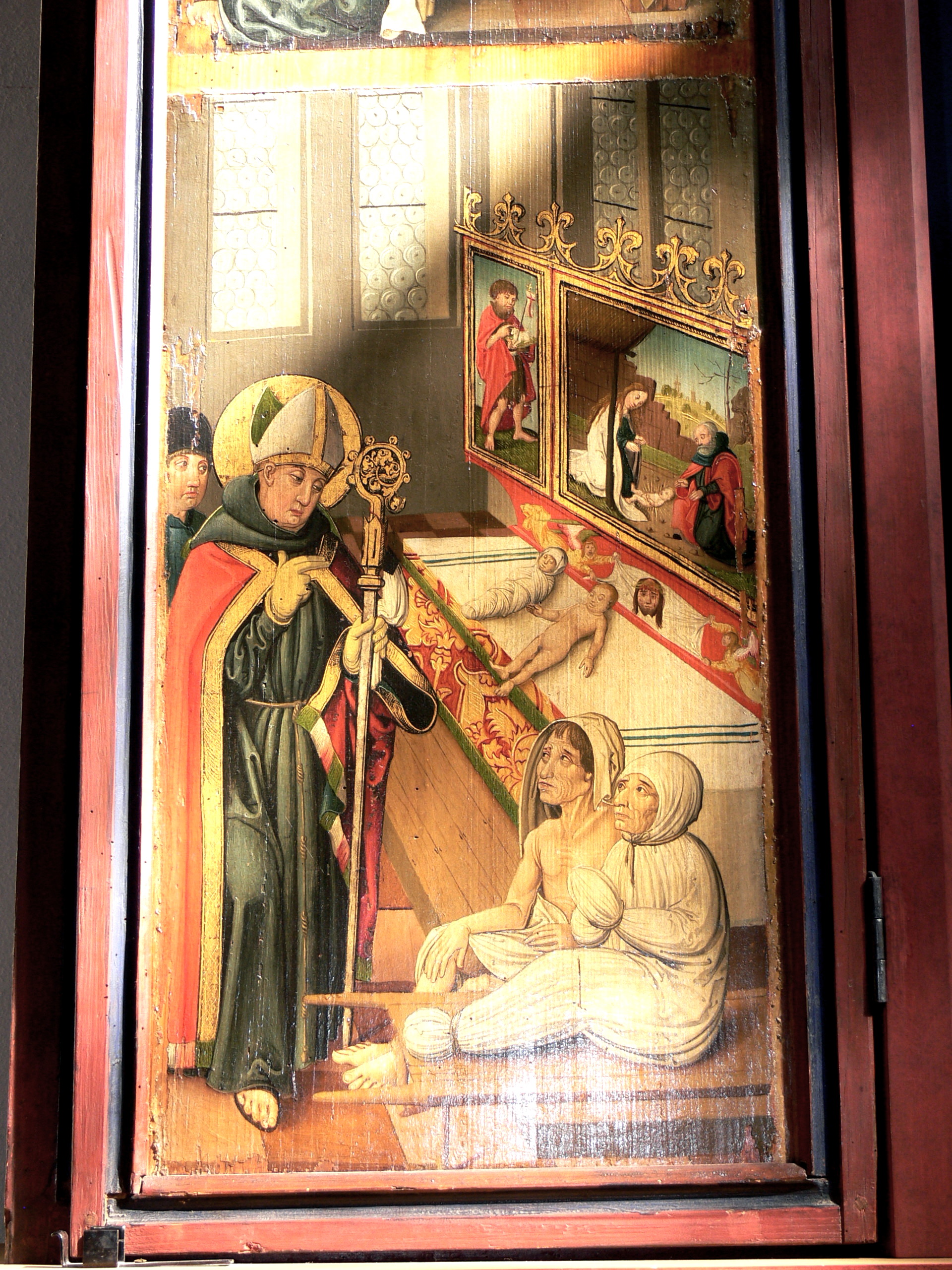John Dillon posted as follows [slightly adapted by the Clever Boy] on the Medieval Religion discussion group
In the Roman Martyrology August 31st is now the day of commemoration of Joseph of Arimathea and Nicodemus (d. 1st cent.).
These two Gospel figures were remembered in medieval Christianity primarily for their roles in the recovery of Jesus' body after the Crucifixion and its subsequent entombment. Starting at least with the Gospel of Nicodemus their acta were enlarged and embroidered upon. By the tenth century there was an Eastern tradition, preserved in a text in Georgian said to have been translated from Syriac, that Joseph of Arimathea was the founder of the church of Lydda. In the later Middle Ages he was reputed to have arrived in Provence with Lazarus, Martha, and Mary and to have gone on to evangelize in, depending on what text one is reading, parts of today's France, Spain, Portugal, or England [ Well we all know in England taht he came to Glastonbury - Clever Boy].
Nicodemus, who was said to to have removed the crucifixion nails from Jesus' body, was credited legendarily with the creation of that famous crucifix, the Holy Face (Volto Santo) of Lucca. In the legends of the Finding of St. Stephen Protomartyr, Nicodemus is said to have been buried by Gamaliel in Stephen's secret grave, into which were also placed Gamaliel's son Abibus and, when his time came, Gamaliel himself. Liturgical commemoration on August 2nd or 3rd of this supposed discovery insured Nicodemus' ongoing if not entirely robust construction as a saint in both the Eastern and Western Middle Ages.
Some visuals:
a) In the Church of the Holy Sepulchre in Jerusalem, the Stone of Anointing on which Joseph of Arimathea is said to have prepared Jesus' body for burial:
http://tinyurl.com/6mdmp6
http://tinyurl.com/68p8a5
b) The so-called Tomb of Joseph of Arimathea (rock-cut grave shafts) in the Church of the Holy Sepulchre in Jerusalem:
http://tinyurl.com/3yyofvb
http://198.62.75.1/www1/jhs/JHS-arimath-a.jpg
http://tinyurl.com/5oukb4
c) The Holy Face / Volto Santo of Lucca (late eleventh-century, with subsequent adornments):
https://c1.staticflickr.com/3/2621/4192466265_f8599d903e_b.jpg
Some medieval images of Joseph of Arimathea and Nicodemus:
d) Joseph of Arimathea (holding Jesus) and Nicodemus (lower right, with forceps and vessel) at the Entombment as depicted in the late eleventh- or early twelfth-century so-called Gospels of Matilda of Canossa in the Museo diocesano d'arte sacra e benedettino at Nonantola (MO) in Emilia-Romagna:
http://tinyurl.com/5fmht6
e) Joseph of Arimathea and Nicodemus as depicted in two panels of the mid-twelfth-century Passion of Christ window (1145-1155) in the cathedral of Notre-Dame at Chartres:
1) Joseph of Arimathea (centre, holding Jesus) and Nicodemus (lower right, with forceps) at the Deposition:
http://tinyurl.com/nhkfxas
2) Joseph of Arimathea (middle register, far left) and Nicodemus (middle register, far right) at the Entombment:
http://tinyurl.com/qxhay7k
f) Joseph of Arimathea (on ladder, holding Jesus) and Nicodemus (at lower right, with forceps and vessel) as depicted in a later twelfth-century fresco of the Deposition from the Cross (ca. 1164) in the north chapel of the church of St. Panteleimon (Pantaleon) at Gorno Nerezi (Skopje municipality) in the Former Yugoslav Republic of Macedonia:
https://plus.google.com/photos/110067756467697073060/albums/5249084478545217697/5249088925958265666?pid=5249088925958265666&oid=110067756467697073060
g) Joseph of Arimathea (holding Jesus) and Nicodemus (on the ladder) as portrayed in Benedetto Antelami's later twelfth-century relief of the Deposition from the Cross (ca. 1178) in the cathedral of Parma:
h) Joseph of Arimathea (lower right, asking Pilate for Jesus' body) as depicted in the late twelfth-century Navarre Picture Bible (1197; Amiens, Bibliothèque Louis Aragon, ms. 108, fol. 189v):
http://www.enluminures.culture.fr/Wave/savimage/enlumine/irht3/IRHT_060259-p.jpg
i) Joseph of Arimathea (holding Jesus) and Nicodemus (at the foot of the Cross) as depicted by Enrico di Tedice in a later thirteenth-century panel painting (1260s) in the Museo nazionale di San Martino, Pisa:

j) Nicodemus (in the illumination in the right-hand column; at the invention of Stephen, Gamaliel, Nicodemus, and Abibo) as depicted in a late thirteenth-century copy of French origin of the Legenda aurea (San Marino, CA, Huntington Library, ms. HM 3027, fol. 90r; image expandable):
http://tinyurl.com/24lqdjl
k) Joseph of Arimathea and Nicodemus as depicted by Pietro Lorenzetti in two earlier fourteenth-century frescoes (ca. 1320) in the lower church of the basilica di San Francesco, Assisi:
1) Joseph of Arimathea (centre left) and Nicodemus (right, with forceps) at the Deposition:
http://www.wga.hu/art/l/lorenzet/pietro/1/3arch/3deposit.jpg
2) Joseph of Arimathea (at left) and Nicodemus (centre right) at the Entombment:
http://www.wga.hu/art/l/lorenzet/pietro/1/3arch/4entomb.jpg
l) Four scenes, in three different different locations, in the earlier fourteenth-century frescoes (betw. 1335 and 1350) of the church of the Holy Ascension at the Visoki Dečani monastery near Peć in, depending on one's view of the matter, either the Republic of Kosovo or Serbia's province of Kosovo and Metohija
1) Joseph of Arimathea (at right) asking Pilate for Jesus' body:
http://tinyurl.com/26gxvo7
2) Joseph of Arimathea (at left) and Nicodemus at upper right (the smaller figure at lower right is presumably an assistant) at the Deposition:
http://tinyurl.com/3958drl
3) Nicodemus (rear left) and Joseph of Arimathea (rear right) in the Lamentation:
http://tinyurl.com/22sr5f7
Detail view:
http://tinyurl.com/2e9jnjx
4) Nicodemus (centre left) and Joseph of Arimathea (centre right) carrying Jesus at the Entombment:
http://tinyurl.com/277poab
Detail view:
http://tinyurl.com/275xzac
m) Nicodemus (nimbed) along with the also nimbed Gamaliel, Stephen, and Abibus in their uncovered grave at the Finding of Stephen as depicted by Bernardo Daddi (attrib.) in one of his mid-fourteenth-century predella paintings devoted to St. Stephen (ca. 1345) in the Pinacoteca Vaticana (from the point of view of the clerical discoverers Nicodemus is probably the first or the third corpse from left, as the one between these is clearly identifiable by vestment as the presumed deacon Stephen and the relatively youthful corpse at far right will be Abibus):
http://www.atlantedellarteitaliana.it/immagine/00023/15329OP368AU24434.jpg
For a different identification of the four nimbed corpses, see this from the Musei Vaticani, where the painting is titled the Ritrovamento dei corpi dei Santi Luciano (the person to whom the long-dead Gamaliel had appeared in a revelatory dream and thus one of those involved in the Finding), Abibo, Nicodemo, and Stefano:
http://mv.vatican.va/2_IT/pages/PIN/PIN_Sala01_04.html
n) Joseph of Arimathea (at left) and Nicodemus holding Jesus' body as depicted in Rogier van der Weyden's earlier fifteenth-century Deposition Altar (circa 1435) in the Museo del Prado, Madrid:
and
http://www.abcgallery.com/W/weyden/weyden5.html
o) Joseph of Arimathea (behind Jesus) and Nicodemus (at Jesus' left) as depicted by Hugo van der Goes in a later fifteenth-century panel painting of the Lamentation (ca. 1470) in the Kunsthistorisches Museum in Vienna:
p) Joseph of Arimathea and Nicodemus as depicted by Simon Marmion in a later fifteenth-century panel painting of the Lamentation (early 1470s) in the Metropolitan Museum of Art, New York:
http://tinyurl.com/6n5zax - which has notes on its commissioning by Duke Charles the Bold of Burgundy and his wife Margaret of York.
http://tinyurl.com/6jktlv
q) Joseph of Arimathea (top centre) and Nicodemus (centre right, with vessel) as depicted in a late fifteenth-century icon in the State Tretyakov Gallery, Moscow:
http://www.icon-art.info/masterpiece.php?lng=en&mst_id=368
r) Nicodemus (at left) and Joseph of Arimathea (at right) as portrayed in a late fifteenth-century polychromed wooden sculpture of the Entombment (ca. 1485) in the abbaye Saint-Pierre at Moissac:

Gordon Plumb posted some further medieval images of St Joseph of Arimathea in stained glass and wall paintings:
Twycross, St James, Leicestershire, east window, panel originally in the Passion window in Bay H of the Sainte Chapelle, Paris, c.1245:
https://www.flickr.com/photos/22274117@N08/2198755430
and detail:
https://www.flickr.com/photos/22274117@N08/2365561815
Croughton, All Saints, Northamptonshire, nave north wall, Descent from the Cross wall painting, early 14thC.:
https://www.flickr.com/photos/22274117@N08/2937011873
and detail of heads:
https://www.flickr.com/photos/22274117@N08/2936980975
Lichfield Cathedral, Staffordshire, sIV, 2b, Descent from the Cross, originally from Herkenrode Abbey in Belgium. 1532-39:
https://www.flickr.com/photos/22274117@N08/15294316410
Langport, All Saints, Somerset, east window, 2e-3e, 15thC.:
https://www.flickr.com/photos/22274117@N08/2552016934
and detail:
https://www.flickr.com/photos/22274117@N08/2551195359
Shrewsbury, St Mary, Trinity Chapel, window from St Jacques Liège c.1535:
Though this originally was part of a Trinity and the incumbent, feeling it was improper to represent God, hadt a turban put in place of the top of God's head and the Dove of the Holy Spirit was moved to a tracery light in the window! So a made-up representation of Joseph, but interesting historically nevertheless!
https://www.flickr.com/photos/22274117@N08/3180707818
and detail of centre panel:
https://www.flickr.com/photos/22274117@N08/3180711922


















